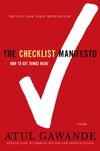
The Checklist Manifesto: How to Get Things Right

Surgery has, essentially, four big killers wherever it is done in the world: infection, bleeding, unsafe anesthesia, and what can only be called the unexpected. For the first three, science and experience have given us some straightforward and valuable preventive measures we think we consistently follow but don’t.
Atul Gawande • The Checklist Manifesto: How to Get Things Right
Checklists seem to provide protection against such failures. They remind us of the minimum necessary steps and make them explicit. They not only offer the possibility of verification but also instill a kind of discipline of higher performance.
Atul Gawande • The Checklist Manifesto: How to Get Things Right
“A building is like a body,” he said. It has a skin. It has a skeleton. It has a vascular system—the plumbing. It has a breathing system—the ventilation. It has a nervous system—the wiring. All together, he explained, projects today involve some sixteen different trades. He pulled out the construction plans for a four-hundred-foot-tall skyscraper
... See moreAtul Gawande • The Checklist Manifesto: How to Get Things Right
The ninth edition of the World Health Organization’s international classification of diseases has grown to distinguish more than thirteen thousand different diseases, syndromes, and types of injury—more than thirteen thousand different ways, in other words, that the body can fail.
Atul Gawande • The Checklist Manifesto: How to Get Things Right
The second type of failure the philosophers call ineptitude—because in these instances the knowledge exists, yet we fail to apply it correctly. This is the skyscraper that is built wrong and collapses, the snowstorm whose signs the meteorologist just plain missed, the stab wound from a weapon the doctors forgot to ask about.
Atul Gawande • The Checklist Manifesto: How to Get Things Right
Nonetheless, even with fortune on their side, there remained every possibility that 155 lives could have been lost that day. But what rescued them was something more exceptional, difficult, crucial, and, yes, heroic than flight ability. The crew of US Airways Flight 1549 showed an ability to adhere to vital procedures when it mattered most, to
... See moreAtul Gawande • The Checklist Manifesto: How to Get Things Right
As Roth explained in his memoir, Crazy from the Heat, “Van Halen was the first band to take huge productions into tertiary, third-level markets. We’d pull up with nine eighteen-wheeler trucks, full of gear, where the standard was three trucks, max. And there were many, many technical errors—whether it was the girders couldn’t support the weight, or
... See moreAtul Gawande • The Checklist Manifesto: How to Get Things Right
Their insistence that people talk to one another about each case, at least just for a minute before starting, was basically a strategy to foster teamwork
Atul Gawande • The Checklist Manifesto: How to Get Things Right
people can lull themselves into skipping steps even when they remember them.